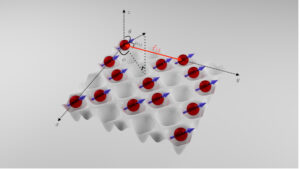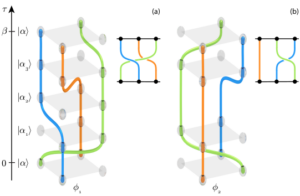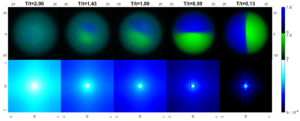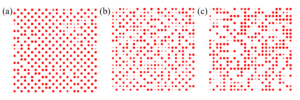Quantum phases of dipolar bosons in a square lattice (current)

Long-range interactions have attracted a great deal of attention in the cold atom community as they have been theoretically shown to stabilize a plethora of exotic quantum phases. State-of-the-art ultracold experiments have paved the way to experimentally explore these exotic phases. Motivated by breakthrough experiments with ultracold magnetic atoms trapped in optical lattices where the orientation of atomic dipoles can be fully controlled by external fields (Science 352, 201 (2016)), we have studied, by means of quantum Monte Carlo, the ground state properties of dipolar bosons trapped in a two-dimensional lattice with density-induced hopping. The effective model describing the system is the extended Bose-Hubbard model. The parameters entering the effective model are calculated starting from the parameters that can be tuned experimentally, e.g. scattering length and dipole moment which both contribute to the onsite interaction, long-range interaction, and strength of density-induced hopping.
Braiding properties of worldline configurations in hardcore lattice boson systems (current)

Within the path-integral approach of quantum mechanics, transition probability amplitudes and, more in general, measures of quantum correlations can be computed in terms of superpositions of classical paths. Within this picture, all possible routes are taken into account but only those which superpose constructively will contribute the most to the quantum physical process. Therefore, there exists a parallel between a certain quantum process and a set of classical possibilities which result in the same outcome.We propose to exploit this analogy and introduce a new framework based on the path-integral formulation. Our ultimate goal is to gain new perspectives in terms of constructive phenomena that collectively lead to quantum correlations in a many-body system.
Multicomponent lattice bosons (past)

Multicomponent lattice bosons can be realized by loading an optical lattice with different atomic species or with the same atomic species in different internal states. They can also be realized in multi-layered systems where tunneling between layers is suppressed but particles belonging to different layers interact with each others via, e.g., dipolar interactions. In these setups, ‘multimers’ — bound complexes of elementary units — can be stabilized. As an example, in the case of a stack of layers, a multimer is a chain formed by one particle per layer and extending across the layers.
Disordered dipolar lattice bosons (past)

Ultracold gases offer an unprecedented opportunity to engineer disorder and interactions in a controlled manner. In these systems, the interplay between disorder, interaction and quantum degeneracy gives rise to new fascinating phenomena. For lattice bosons, as described by the Bose-Hubbard model in the presence of on-site, bound disorder, it was proven analytically and confirmed numerically that the gapless Bose glass phase, characterized by finite compressibility and absence of off-diagonal long-range order, always intervenes between the Mott-insulator and superfluid state. In an effort to understand the interplay between disorder, dipolar interaction and quantum degeneracy, we have studied a variety of two-dimensional dipolar lattice bosons in the presence of disorder.